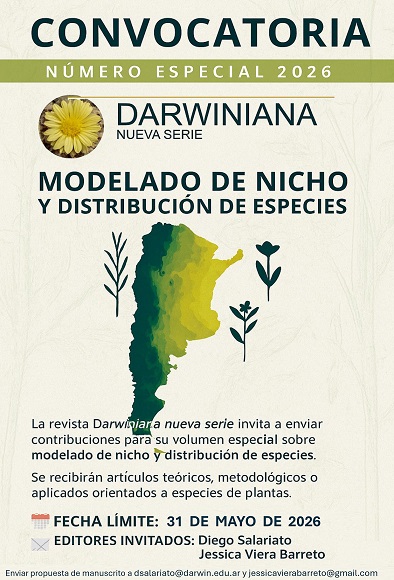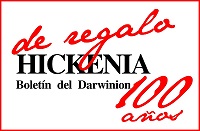Hibridación local en hábitats de montaña subtropicales: ¿Cedrela (Meliaceae) puede mantener la identidad de las especies en simpatría?
DOI:
https://doi.org/10.14522/darwiniana.2016.42.715Palabras clave:
Argentina, Cedrela angustifolia, Cedrela balansae, Cedrela saltensis, Yungas.Resumen
Las especies congéneres con barreras reproductivas incompletas que coexisten a lo largo de un gradiente ambiental pueden ser proclives a la divergencia ecológica, a pesar del potencial de hibridación en simpatría. Estudiamos los patrones de distribución de isoenzimas y de secuencias de ADN nuclear y plastidial a escala local y regional en las tres especies de árboles del género Cedrela del subtrópico de noroeste de Argentina para analizar si las poblaciones de las distintas especies han divergido en sus hábitats montanos en relación a sus características ecológicas. Cedrela balansae y C. angustifolia pueden ser identificadas por alelos isoenzimáticos diagnósticos. Las secuencias nucleares del ITS mostraron polimorfismo intraindividual; bases ambiguas fueron compartidas entre C. balansae y C. saltensis, mientras que en C. angustifolia es parte de su polimorfismo intraespecífico. El ADN del cloroplasto consistió en un haplotipo compartido entre las especies de baja altitud C. balansae y C. saltensis y otro diferente para C. angustifolia el cual comparte con las otras dos especies cuando están en simpatría. Los análisis de UPGMA de isoenzimas y filogenético bayesiano de haplotipos del ITS muestran patrones concordantes. Las poblaciones de C. angustifolia se agruparon dentro de un mismo cluster y se separaron de las de C. saltensis y C. balansae que se mantuvieron agrupadas. Esto indica que existen barreras reproductivas entre C. angustifolia y los otros taxa de baja elevación C. saltensis y C. balansae, las cuales mantienen un continuo flujo génico. No obstante, bajo los distintos ambientes que ocupan, las tres especies hibridaron en algún momento en el pasado y más tarde comenzaron a diferenciarse a través de divergencia ecológica.
Citas
Acosta, M. C. & A. C. Premoli. 2010. Evidence of chloroplast capture in South American Nothofagus (subgenus Nothofagus, Nothofagaceae). Molecular Phylogenetics and Evolution 54: 235-242. DOI: 10.1016/j.ympev.2009.08.008
Akaike, H. 1973. Information theory and an extension of the maximum likelihood principle, in Petrov B. N. & F. Caski (eds.), [Proceedings of the 2nd International Symposium on Information Theory]. Budapest: Akadémiai Kiado, 267-281.
Cavers, S.; A. Telford, F. Arenal Cruz, A. J. Pérez Castañeda, R. Valencia, C. Navarro, A. Buonamici & A. J. Lowe. 2013. Cryptic species and phylogeographical structure in the tree Cedrela odorata L. throughout the Neotropics. Journal of Biogeography 40: 732-746. DOI: 10.1111/jbi.12086
Coyne, J. A. & H. A. Orr. 2004. Speciation. Suderland, MA: Sinauer.
Demesure B.; N. Sodzi & R. J. Petit. 1995. A set of universal primers for amplification of polymorphic non-coding regions of mitochondrial and chloroplast DNA in plants. Molecular Ecology 4: 129-131. DOI: 10.1111/j.1365-294X.1995.tb00201.x
Dumolin, S.; B. Demesure & R. J. Petit. 1995. Inheritance of chloroplast and mitochondrial genomes in pedunculate oak investigated with an efficient PCR method. Theoretical and Applied Genetics 91: 1253-1256. DOI: 10.1007/BF00220937
Fehrer, J.; B. Gemeinholzer, J. Chrtek & S. Bräutigam. 2007. Incongruent plastid and nuclear DNA phylogenies reveal ancient intergeneric hybridization in Pilosella hawkweeds (Hieracium, Cichorieae, Asteraceae). Molecular Phylogenetics and Evolution 42: 347-361. DOI: 10.1016/j.ympev.2006.07.004
Garcia-Gonçalvez, M.; R. S. Silva, M. A. Carniello, J. W. Veldman, A. A. B. Rossi & L. O. de Oliveira. 2011. Molecular evidence of cryptic speciation, historical range expansion, and recent intraspecific hybridization in the Neotropical seasonal forest tree Cedrela fissilis (Meliaceae). Molecular Phylogenetics and Evolution 61(3): 639-649. DOI: 10.1016/j.ympev.2011.08.026
Goudet, G. 1995. FSTAT (Version 1.2): A Computer Program to Calculate F-Statistics. Journal of Heredity 86(6): 485-486.
Grau, A.; M. A. Zapater & R. A. Neumann. 2006. Botánica y distribución del género Cedrela en el noroeste de Argentina, en Pacheco S. & A. Brown (eds.), Ecología y producción de cedro (género Cedrela) en las Yungas australes: 19-30. Tucumán: Ediciones del Subtrópico.
Hamilton, M. B. 1999. Four primer pairs for the amplification of chloroplast intergenic regions with intraspecific variation. Molecular Ecology 8(3): 521-523.
Koch, M. A.; C. Dobeš & T. Mitchell-Olds. 2003. Multiple hybrid formation in natural populations: concerted evolution of the internal transcribed spacer of nuclear ribosomal DNA (ITS) in North American Arabis divaricarpa (Brassicaceae). Molecular Biology and Evolution 20(3): 338-350. DOI: 10.1093/molbev/msg046
Köcke, A. V. 2015. Spatio-temporal evolution of Cedrela (Meliaceae): climatic niche dynamics, phylogeography and taxonomy. PhD Thesis, Johann Wolfgang Goethe Univesity, Germany.
Koecke, A.; A. Muellner-Riehl, T. D. Pennington, G. Schorr & J. Schnitzler. 2013. Niche evolution through time and across continents: the story of the neotropical Cedrela (Meliaceae). American Journal of Botany 100: 1800-1810. DOI: 10.3732/ajb.1300059
Koenen, E. J. M.; J. J. Clarkson, T. D. Pennington & L. W. Chatrou. 2015. Recently evolved diversity and convergent radiations of rainforest mahoganies (Meliaceae) shed new light on the origins of rainforest hyperdiversity. New Phytologist 207(2): 327-339. DOI: 10.1111/nph.13490
Librado, P. & J. Rozas. 2009. DnaSP v5: a software for comprehensive analysis of DNA polymorphism data. Bioinformatics 25(11): 1451-1452. DOI: 10.1093/bioinformatics/btp187
Malizia L. R.; C. Blundo, S. E. Pacheco. 2006. Diversidad, estructura y distribución de bosques con cedro (Cedrelas pp., Meliaceae) en noroeste de Argentina y sur de Bolivia, En: Pacheco, S. & A. Brown (eds.), Ecología y producción de cedro (género Cedrela) en las Yungas australes: 83-104. Tucumán: Ediciones del Subtrópico,
Mayr, E. 1947. Ecological factors in speciation. Evolution 1(4): 263–288. DOI: 10.2307/2405327
Mitton. J. B.; Y. B. Linhart, K. B. Sturgeon & J. L. Hamrick. 1979. Allozyme polymorphisms detected in mature needle of ponderosa pine. Journal of Heredity 70: 86-89.
Muellner, A. N.; R. Samuel, M. W. Chase, C. M. Pannell & H. Greger. 2005. Aglaia (Meliaceae): an evaluation of taxonomic concepts based on DNA data and secondary metabolites. American Journal of Botany 92(3): 534-543. DOI: 10.3732/ajb.92.3.534
Muellner, A. N.; T. D. Pennington & M. W. Chase. 2009. Molecular phylogenetics of neotropical Cedreleae (mahogany family, Meliaceae) based on nuclear and plastid DNA sequences reveal multiple origins of “Cedrela odorata”. Molecular Phylogenetics and Evolution 52(2): 461-469. DOI: 10.1016/j.ympev.2009.03.025
Muellner, A. N.; T. D. Pennington, A. V. Koecke & S. S. Renner. 2010. Biogeography of Cedrela (Meliaceae, Sapindales) in Central and South America. American Journal of Botany 97(3): 511-518. DOI: 10.3732/ajb.0900229
Muir, G.; C. C. Fleming & C. Schlötterer. 2001. Three divergent rDNA clusters predate the species divergence in Quercus petraea (Matt.) Liebl. and Quercus robur L. Molecular Biology and Evolution 18(2): 112-119.
Navarro, C.; S. Ward & M. Hernández. 2002. The tree Cedrela odorata (Meliaceae): a morphologically subdivided species in Costa Rica. International Journal of Tropical Biology and Conservation 50: 21-29.
Nylander, J. A. 2004. MrModelTest. Program distributed by the author. Evolutionary Biology Centre, Uppsala University, Uppsala. Available on: http://www.abc.se/~nylander/
Orr, M. R. & T. B. Smith. 1998. Ecology and speciation. Trends in Ecology and Evolution 13(2): 502-506.
Pennington, T. P. & A. N. Muellner. 2010. A monograph of Cedrela (Meliaceae). England: DH Books.
Posada, D. & K. A. Crandall. 1998. Modeltest: testing the model of DNA substitution. Bioinformatics Applications Note 14(9): 817-818. DOI: 10.1093/bioinformatics/14.9.817
Poulik, M. D. 1957. Starch gel electrophoresis in a discontinuous system of buffers. Nature (London) 180: 1477-1479. DOI: 10.1038/1801477a0
Premoli, A. C., C. P. Souto, S. Trujillo A., R. del Castillo, P. Quiroga, T. Kitzberger, Z. Gomez O., M. Arbetman, L. R. Malizia, A. Grau, R. Rivera G. & A.C. Newton. 2011. Impact of forest fragmentation and degradation on patterns of genetic variation and its implication for forest restoration. In: Principles and Practice of Forest Landscape Restoration. Case studies from the drylands of Latin America (eds. A.C. Newton & N. Tejedor G.) International Union for the Conservation of Nature.
Ranker, T. A.; C. H. Haufler, P. S. Soltis & D. E. Soltis. 1989. Genetic evidence for allopolyploidy in the neotropical fern Hemionitis pinnatifida (Adiantaceae) and the reconstruction of an ancestral genome. Systematic Botany 14(4): 439-447. DOI: 10.2307/2418989
Rieseberg, L. H. & D. E. Soltis. 1991. Phylogenetic consequences of cytoplasmic gene flow in plants. Evolutionary Trends in Plants 5(1): 65-84.
Ronquist, F. & J. P. Huelsenbeck. 2003. MrBayes 3: Bayesian phylogenetic inference under mixed models. Bioinformatics 19(12): 1572-1574. DOI: 10.1093/bioinformatics/btg180
Rundle, H. D. & P. Nosil. 2005. Ecological speciation. Ecology Letters 8: 336-352.
Schluter, D. 2001. Ecology and the origin of species. Trends in Ecology & Evolution, 16(7): 372-380.
Taberlet, P.; L. Gielly, G. Pautou & J. Bouvet. 1991. Universal primers for amplification of three non-coding regions of chloroplast DNA. Plant Molecular Biology 17(5): 1105-1109.
Tamura, K.; J. Dudley, M. Nei & S. Kumar 2007. MEGA4 : Molecular Evolutionary Genetics Analysis (MEGA) Software Version 4.0. Molecular Biology and Evolution 24: 1596-1599. DOI: 10.1093/molbev/msm092
Wright, S. 1965. The interpretation of population structure by F-statistics with special regard to systems of mating. Evolution 19(3): 358-420. DOI: 10.2307/2406450
Wright, S. 1978. Evolution and the genetics of populations, vol. 4: Variability within and among natural populations. Chicago: University of Chicago Press.
Yeh, F.C. & T. J. B. Boyle. 1997. Population genetic analysis of co-dominant and dominant markers and quantitative traits. Belgian Journal of Botany 129: 157-163.
Zapater, M. A.; E. M. del Castillo, & T. D. Pennington. 2004. El género Cedrela (Meliaceae) en la Argentina. Darwiniana 42: 347-356.
Zelener, N.; D. Tosto, L. O. de Oliveira, M. A. Soldati, M. V. Inza, & L. F. Fornes. 2016. Molecular evidence of hybrid zones of Cedrela (Meliaceae) in the Yungas of Northwestern Argentina. Molecular Phylogenetic and Evolution 102: 45-55.
Descargas
Publicado
Cómo citar
Número
Sección
Licencia

A partir de 2012, esta obra está licenciada bajo una Licencia Creative Commons Atribución-NoComercial 2.5 Argentina .
Cualquier obra derivada deberá estar previamente autorizada con nota escrita de los editores.








